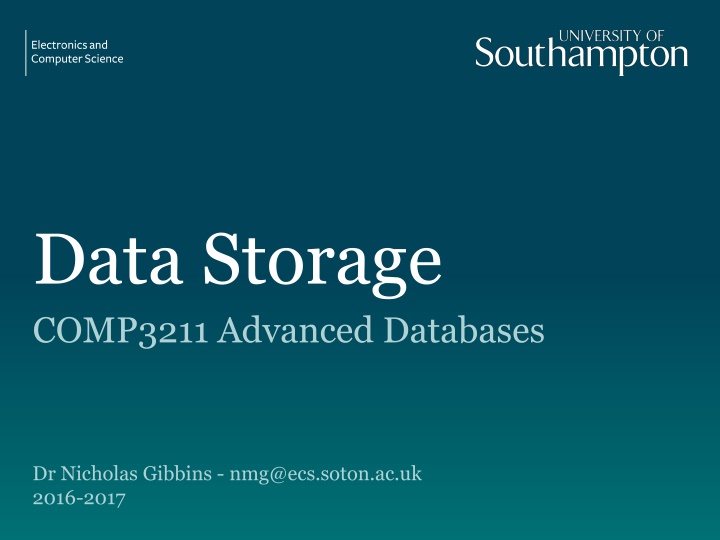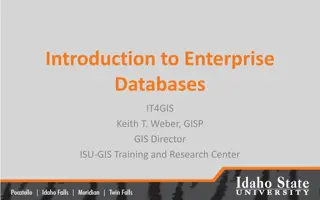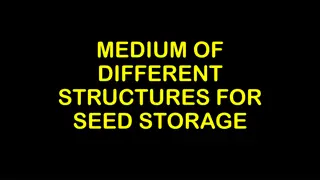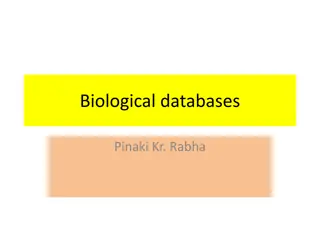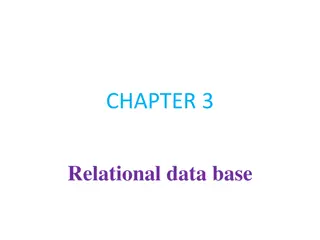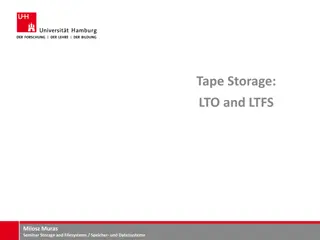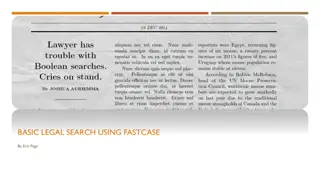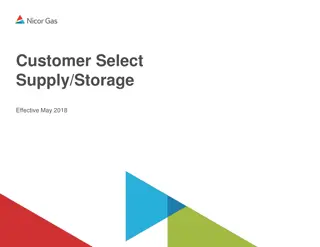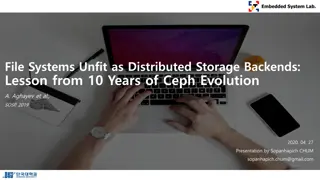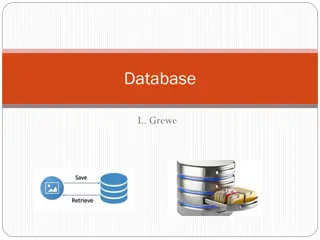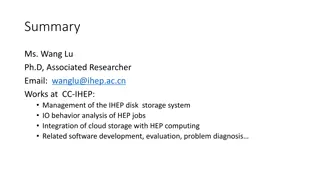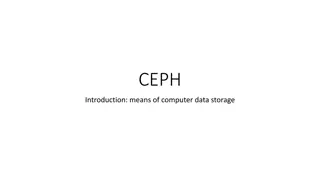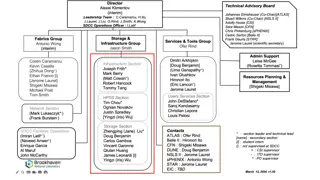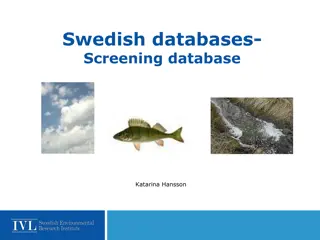Advanced Databases and Storage Organization
This content discusses advanced topics in databases and storage organization, covering the memory hierarchy, secondary storage, buffer management, disk organization, and more. It delves into the concepts of cache, volatile storage, main memory, secondary storage, and tertiary storage, providing insights into the different storage levels and their characteristics. Additionally, it explores hard disk drives, disk structure, and zone bit recording in the context of data storage and management.
Download Presentation

Please find below an Image/Link to download the presentation.
The content on the website is provided AS IS for your information and personal use only. It may not be sold, licensed, or shared on other websites without obtaining consent from the author.If you encounter any issues during the download, it is possible that the publisher has removed the file from their server.
You are allowed to download the files provided on this website for personal or commercial use, subject to the condition that they are used lawfully. All files are the property of their respective owners.
The content on the website is provided AS IS for your information and personal use only. It may not be sold, licensed, or shared on other websites without obtaining consent from the author.
E N D
Presentation Transcript
Data Storage COMP3211 Advanced Databases Dr Nicholas Gibbins - nmg@ecs.soton.ac.uk 2016-2017
Overview Storage Organisation Secondary storage Buffer management The Five-Minute Rule Disk Organisation Data Items Records Blocks
Storage Organisation
The Memory Hierarchy: Cache Volatile storage Very fast, very expensive, limited capacity Cache Hierarchical Main Memory Typical capacities and access times: Secondary Storage -Registers ~101bytes, 1 cycle -L1 ~104bytes, <5 cycles Tertiary Storage -L2 ~105bytes, 5-10 cycles
The Memory Hierarchy: Main Memory Volatile storage Fast, affordable, medium capacity Cache Main Memory Typical capacity: 109-1010 bytes Typical access time: 10-8 s (20-30 cycles) Secondary Storage Tertiary Storage
The Memory Hierarchy: Secondary Storage Non-volatile storage Slow, cheap, large capacity Cache Main Memory Typical capacity: 1011-1012 bytes Typical access time: 10-3 s (106 cycles) Secondary Storage Tertiary Storage
The Memory Hierarchy: Tertiary Storage Non-volatile storage Very slow, very cheap, very large capacity Cache Main Memory Typical capacity: 1013-1017 bytes Secondary Storage Typical access time: 101-102 s Tertiary Storage
Secondary Storage
Hard Disk Drives Typical secondary storage medium for databases Terms: -Platter, surface, head, actuator, cylinder, track, sector, block, gap
Disk Structure A track B geometrical sector C track sector D cluster
Zone Bit Recording Tracks closer to the disc edge are longer than those closer to the axis -Bit densities vary in order to ensure a constant number of bits per sector Instead, we can vary the number of sectors per track (depending on track location) -Improves overall storage density
Disk Access Time: Reading Access Time = Seek Time + block requested Rotational Delay + Transfer Time access time block in memory
Seek Time Time taken for head assembly to move to a given track Average seek time range: 4ms for high end drives 15ms for mobile devices
Rotational Delay (Latency) Average delay = time for 0.5 rev Rotational speed [rpm] Average delay [ms] 4,200 5,400 7,200 10,000 15,000 7.14 5.56 4.17 3.00 2.00 head position requested block
Transfer Time Transfer rate ranges from: up to 1000 Mbit/sec 432 Mbit/sec 12x Blu-Ray disk 1.23 Mbits/sec 1x CD for SSDs, limited by interface e.g., SATA 3000 Mbit/s Transfer time = block size / transfer rate
Sequential Access So far, random access - what about reading next block? Access time = ( block size / transfer rate ) + negligible costs Negligible costs: skip inter-block gap switch track (within same cylinder) switch to adjacent cylinder occasionally In general, sequential i/o is much less expensive than random i/o
Disk Access Time: Writing Costs similar to those for reading, unless we wish to verify data Verifying requires that we read the block we ve just written Access Time = Seek Time + Rotational Delay (1/2 rotation) + Transfer Time (for writing) + Rotational Delay (full rotation) + Transfer Time (for verifying)
Disk Access Time: Modifying 1. Read Block 2. Modify in Memory 3. Write Block 4. Verify Block (optional)
Disk Access Time: Modifying Access Time = Seek Time + Rotational Delay (1/2 rotation) + Transfer Time (for reading) + Rotational Delay (full rotation) + Transfer Time (for writing) + Rotational Delay (full rotation) + Transfer Time (for verifying) [ ]
Block Addressing Cylinder-head-sector Physical location of data on disk ZBR causes problems (sectors vary by tracks) Logical Block Addressing Blocks located by integer index HDD firmware maps LBA addresses to physical locations on disk Allows remapping of bad blocks
Block Size Selection? The size of blocks affects I/O efficiency: Big blocks reduce the costs of access Fewer seeks (seek time + rotational delay) for the same amount of data Big blocks also increase the amount of irrelevant data read If you re trying to read a single record in a block, larger blocks force you to read more data
Solid State Drives Typically based on NAND flash memory Considerably more expensive than HDD (~8-9x) Typically smaller maximum size than HDD (~1-2TB) Considerably higher I/O performance Asymmetric read/write performance (writes are slower) Limited number of program-erase cycles (~100,000)
HDD versus SSD Random I/Os per second (IOPS) = 1/ (seek + latency + transfer) HDD * 125-150 IOPS 125-150 IOPS SSD ** ~50,000 IOPS ~40,000 IOPS Random Read IOPS Random Write IOPS * ** Assumes 10,000 rpm HDD with SATA 3Gb/s interface OCZ 480GB Vertex 3 (c. 2012) with SATA 6Gb/s interface
Buffer Management
The Buffer Pool Far more blocks of secondary storage than space in main memory need to be selective about what s kept in memory Buffer pool organised into frames (size of database block, plus metadata) X X X disk higher-level code buffer pool
Buffer Metadata Each frame in the buffer pool has: a pin count (number of current users of the block in that frame) a dirty flag (1 if the copy in the buffer has been changed, 0 otherwise) an access time (optional used for LRU replacement) a loading time (optional used for FIFO replacement) a clock flag (optional used for Clock replacement)
Requesting a Block if thenincrement pin count ( pin the block ) elseif there is an empty frame then read block into frame and set pin count to 1 else choose a frame to be replaced if dirty bit on the replacement frame is set then write block in replacement frame to disk endif read requested block into replacement frame endif endif buffer pool already has a frame containing the block
Buffer Replacement Strategies A frame will not be selected for replacement until its pin count is 0 If there s more than one frame with a pin count of 0, use a replacement strategy to choose the frame to be replaced Least Recently Used (LRU) Select the frame with the oldest access time First In First Out (FIFO) Select the frame with the oldest loading time Clock Approximation of LRU cycle through each buffer in turn, if a buffer hasn t been accessed in a full cycle then mark it for replacement
Single Buffering 1. Read B1 Buffer 2. Process Data in Buffer 3. Read B2 Buffer 4. Process Data in Buffer ...
Single Buffering Buffer load from disk Disk B1 B2 B3 B4 B5 B6 B7 B8
Single Buffering Buffer B1 process block Disk B1 B2 B3 B4 B5 B6 B7 B8
Single Buffering Buffer load from disk Disk B1 B2 B3 B4 B5 B6 B7 B8
Single Buffering Buffer B2 process block Disk B1 B2 B3 B4 B5 B6 B7 B8
Single Buffering Buffer load from disk Disk B1 B2 B3 B4 B5 B6 B7 B8
Single Buffering Cost Single buffer time = n(P + R) where P = time to process a block R = time to read a block n = number of blocks
Double Buffering Use a pair of buffers: While reading a block and writing into buffer A Process block previously read into buffer B After block read into A, process A and read next block into B
Double Buffering Buffer load from disk Disk B1 B2 B3 B4 B5 B6 B7 B8
Double Buffering process block Buffer B1 load from disk Disk B1 B2 B3 B4 B5 B6 B7 B8
Double Buffering process block Buffer B2 load from disk Disk B1 B2 B3 B4 B5 B6 B7 B8
Double Buffering process block Buffer B3 load from disk Disk B1 B2 B3 B4 B5 B6 B7 B8
Double Buffering process block Buffer B4 load from disk Disk B1 B2 B3 B4 B5 B6 B7 B8
Double Buffering If time to process a block > time to read a block: Double buffer time = R + nP Single buffer time = n(R+P)
The Five Minute Rule
The Five Minute Rule Data referenced every five minutes should be memory resident
The Five Minute Rule The Five Minute Rule for trading memory for disc accesses Jim Gray & Franco Putzolu May 1985 The Five Minute Rule, Ten Years Later Goetz Graefe & Jim Gray December 1997 The five-minute rule 20 years later (and how flash memory changes the rules) Goetz Graefe July 2009
The Five Minute Rule Assume a block is accessed every X seconds: CD = cost if we keep that block on disk $D = cost of disk unit I = number of IOs that unit can perform per second In X seconds, unit can do XI IOs So, CD = $D / XI
The Five Minute Rule Assume a block is accessed every X seconds: CM = cost if we keep that block in RAM $M = cost of 1MB of RAM P = number of pages in 1MB RAM So CM = $M / P
The Five Minute Rule Assume a block is accessed every X seconds: If CD is smaller than CM, keep block on disk else keep in memory Break even point when CD = CM, or X = ($D P) / (I $M)
Using 1997 numbers P = 128 blocks/MB (8KB pages) I = 64 accesses/sec/disk $D = $2000/disk (9GB HDD + controller) $M = $15/MB of RAM X = 266 seconds (about 5 minutes) (did not change much from 1985 to 1997)
